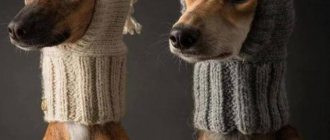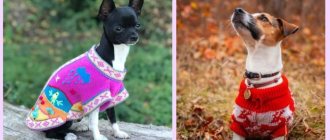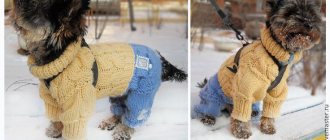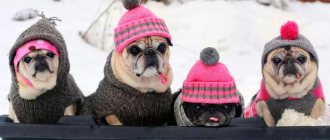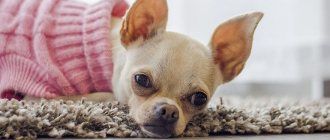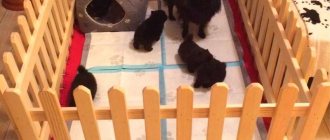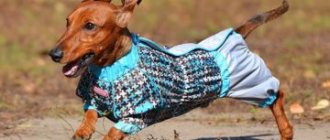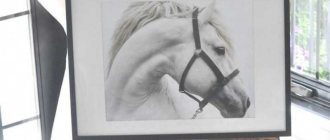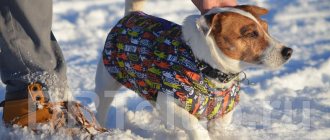The number of loops should be divided by 4. The main measurement is the circumference of the head, where the two-color elastic band runs. We knit from nose to neck. Conditional colors: white and dark.
With white thread we knit a 4-5 cm “roller” face on 4 knitting needles + 2 rows with an elastic band + 4 rows with a two-color elastic band + 1 row with a white elastic band. Divide into 4 parts. Distance between ears = throat part and less side parts. We knit a petal near the ear with a white thread. Same on the other side. Between the ears - an English elastic band to the end of the occipital protuberance with a dark thread. We have two knitting needles left with loops - the throat and the knitted strip between the ears. We cast on the remaining loops, but their number is slightly less than what was at the top of the product. We knit with a simple elastic band. Carefully sew on the dangling petals. We insert the lace around the throat. Well, a lace for the roller.
How to knit petals using 15 loops as an example: We knit with a simple elastic band. 1st row (from top to throat) - just an elastic band 2nd row - close 1 stitch at the throat. underknit 3 stitches at the top row 3 - just an elastic band, 3 stitches remain unknitted row 4 - close 1 stitch at the throat. under-knit 6 stitches at the top row 5 - just an elastic band, 6 stitches remain unknitted row 6 - close 1 stitch at the throat, tie everything off row 7 - just an elastic band 8 row - close off at the throat 2 stitches row 9 - close off
here's a similar one with ears
You can knit this one!
First of all, we need to find out how many knitting loops are in 1 cm. To do this, take the knitting needles and threads with which you are going to knit, and knit a small sample (cast on 10 loops and knit them with a 1x1 elastic band). Measure the head, as shown in the photo. (I show it on the sneeze, because it’s easier to see)
those. measure the circumference (purple line) and semicircle (from ear to ear), approximately to the point where the blue line ends. In general, to avoid confusion, it is better to write down the calculations. Now we subtract the smaller from the larger and write down the results.
According to my calculations, I need to cast on only 44 loops 26 loops - the frontal part 18 loops - the occipital part
We cast on our 26 loops in a way convenient for you. (You can see the methods here) We begin to knit a 1x1 elastic band. Knitted 1-2 centimeters with an elastic band. And we put the remaining 18 loops on the knitting needle (plus or minus 1 loop, see the picture) To avoid “jumps” in the elastic band and shift the pattern, it is better to immediately estimate the number of loops that need to be added to our knitting.
I’ll explain why we didn’t immediately cast the required number of loops. So that the hat on the back of the head does not puff up and slide over the dog’s eyes, but has the correct anatomical shape
We unfold our knitting and knit the cast-on loops, remembering the pattern. Next we will start knitting in the round. We distribute the loops of the frontal part onto 2 knitting needles and continue to knit with an elastic band in a circle.
Having knitted 2-3 cm, we again return to knitting on 2 knitting needles. We divide the total number of loops by 2 and get the answer to how many loops there should be on each knitting needle. In my case - 22 loops. He remembers that the frontal part = 26 loops. Occipital 18. This means that we throw 4 loops onto the “occipital part” knitting needle. But we do it symmetrically from both ends!!! Otherwise the hat will be skewed! They divided it. We have 2 loops at the beginning of the row already knitted, we simply remove them onto the 3rd knitting needle (we knit on 2 knitting needles!!!) and continue knitting until the end of the row. After you and I picked up the loops for the back of the head, we turned our knitting around and went to knit in the other direction. (I hope you remember this) In that place we made a “V”-shaped little “cut”. This is what we have - the end of the series. (then this defect will need to be removed, but I think that I won’t tell you in detail how to do this, everyone can sew) But, you and I must switch to knitting on 2 knitting needles, but for now we have 3 of them. What are we what do we do next? We take a knitting needle and begin to remove loops on this knitting needle one by one. Knit 1, purl 1, alternate 1 stitch on each needle. Those. We do not violate the elastic pattern!!! Now all our knitting is on 1 needle.
You can continue knitting on 3 knitting needles until the end, and before closing, transfer the stitches to 1 knitting needle. Just make sure there is no distortion.
Actually, all we have to do is close the loops and our hat is ready. If you close 2 loops together, it is better to alternate with “3 loops together”, otherwise the edge will stretch.
Let's start decorating.
First of all, we make the ties. Try on the hat and determine the best place for them, because... here the shape of the head plays an important role. We take the thread, fold it in half, pull its end into the loop of the 2nd row of our knitting, and “braid” it with a crochet hook.
Pompoms
We cut out such a part from cardboard (I cut it from a plastic card) in a quantity of 2 pieces.
The diameter of the part will be approximately equal to the diameter of the pompom. Unwinds the thread and folds it 3-4 times. We put our 3 pieces together. We insert the end of the thread into the hole and begin to wind the thread around the part in a circle.
Now take scissors or a blade and cut the threads along the red line.
Next, take a thread about 10-15 cm long (single), insert it between the plates of the part, tighten it and tie a knot. Remove the plastic parts and the pompom is ready to decorate our hat.
The use of any materials from the site is permitted only with a direct active link to the site
Dogs become our best friends. They love us and protect us. We, in turn, must also treat them. It is our duty to make sure that our little and sometimes big friends feel comfortable in the winter.
There are now many specialized clothing stores open for dogs. Outfits are presented for every taste and color. Some people buy clothes just to dress up, while for others it is a vital necessity. But unfortunately for owners, things for their pets often cost them a pretty penny.
How to knit a dog sweater for beginners, diagram with detailed description and photo
For beginners, you can knit this simple dog sweater from warm melange yarn. We will take thick threads, two hundred meters in one hundred grams of yarn. You will need number four knitting needles.
Yarn for work:
First, take measurements from the dog, use the table and description given above. After this, you can start knitting the collar. Try not to make it too tight; the sweater should be easy to put on and not cause discomfort to the dog. The optimal collar width for small dogs is five centimeters. We knit it with a 1x1 or 2x2 elastic band.
We knit the main part of the sweater with a simple stockinette stitch. You can put a pattern in the form of a braid along the back. We will knit the pattern on 17 loops. At the end of the collar, you need to count this number of loops in the middle and knit the pattern according to the diagram below. If you still find patterns difficult, you can knit the entire sweater using satin stitch.
After two rows of the main fabric, we begin to add. Add two loops on each row. We add loops until the width of the fabric reaches the size of the dog in the chest circumference, plus another two centimeters for allowances. Be sure to try the sweater on your dog. To make this easier, place the stitches on circular needles. Then put it back on the stockings. Don’t be lazy to try it on again, so you don’t have to start all over again.
Now you need to make slots for the paws. As shown in the photo, you need to skip the number of loops you need in size, knitting only the side parts from the holes. To do this, knit the first three centimeters, close the next six centimeters, and then knit to the second armhole. And when you get the right one, add air loops and knit further with a single piece of fabric.
Now we need a measurement from the abdomen, length. The fabric tapers towards the bottom of the tummy, so you need to decrease two loops every six rows. Don't forget to try the product on your dog.
Having reached the required length, finish the edge with an elastic band. Six rows are enough. The armholes for the paws would also be good to tie, you can crochet them. The last stage is assembling the sweater, sewing it and trying it on the owner.
We will need
Selecting threads for knitting is a very important point. I do not recommend using 100% wool yarn, as it can be too scratchy. This is especially important for sensitive dogs and pets prone to allergic reactions.
I took Kamtex “Budget” yarn, the composition of which is 40% wool and 60% acrylic. It is better to take yarn in two different colors. After all, we are knitting a deer hat for a dog, and it will look better if the horns are a different color and do not merge with the hat.
It took me about 2/3 of a skein for the main fabric of the hat. But just a little for the horns. But it's very good. After all, from the remaining threads you can easily knit another deer hat and give it for the New Year to your best four-legged friend with whom you spend time on walks.
We will knit the hat itself, and crochet the ears and horns. Therefore, we will need knitting needles and a hook. It is better to take thicker knitting needles. This way the knitting will be more textured and expressive.
I knitted the deer hat with two knitting needles, and then sewed the edges together. This is an easier option for beginners. But the hat can also be knitted with a single piece of fabric. This option is suitable for those who know how to use or who have circular knitting needles.
Crochet pattern for dogs overalls, details
We will crochet number five. You can take the same white or milky yarn (Cinse Artico), or you can choose something brighter. You will also need a pink ribbon, about forty centimeters, and one pearl bead.
We knit according to the pattern: air loop, connecting column, single column. and a column with nak.
Before.
We start knitting the fabric from the waist line. We cast on 81 loops and close it into a ring. Next, using pattern number one, we knit seven centimeters in a circle. Next, the canvas needs to be divided into two parts. The bottom consists of 14 motifs, and the top of 12. Leave 2 motifs between them on both sides. for the armhole. We knit everything according to pattern number one.
Bottom part.
After 10 cm has been passed from the armhole, set aside 7 motifs in the center for the neckline. We knit the right and left parts separately. After 14 cm from the armhole, finish knitting. We knit the second side in the same way.
Top part.
After 10 cm has been passed from the armhole, set aside 6 motifs in the center for the neckline. After 14 cm from the armhole, finish knitting. We sew the details of the bottom and top along the shoulders. The neckline or neckline needs to be tied. To do this, in a circle, first knit 2 rows with single stitches, then 2 rows with stitches. with nak. Use scheme number two.
All that remains is to knit the sleeves and the bottom of the overalls. First we knit the sleeves for the front legs. To do this, we raise the post in the armholes. and knit in circular rows of 10 centimeters using pattern number one. Then make a 4 centimeter column with a nak. according to scheme number two.
Let's move on to the bottom. From the first row along the waist line we knit 20 centimeters according to the first pattern. Then set aside 11 mot. in the middle under the hole for putting on. We knit the left and right sides separately 7 centimeters. At the same time, we perform a decrease, 2 columns. from each side. We sew together the parts of the fabric, not forgetting to leave an opening for putting on and armholes for the paws.
Using the first pattern, we knit in the armholes for the hind legs in a circle of 7 cm. Then make a column cuff without tape. 2 cm.
According to the third pattern, we tie the bottom of the overalls. We make a bow from the ribbon and decorate it with a bead.
LiveInternetLiveInternet
—Categories
- Felts (667)
- Manicure. (0)
- Stained glass, batik, drawing (328)
- Treats (2418)
- Main courses (578)
- Baking bread (65)
- Blanks (189)
- Drinks, desserts (157)
- Decorating goodies (31)
- Recipe collections (39)
- Salads, appetizers (314)
- Soups (38)
- Cakes, pastries, cookies, pies (899)
- Knitting (2783)
- Knitting tips (714)
- Knitting for children (269)
- Crochet (500)
- Knitting for men (22)
- Crochet dresses (144)
- Knitting dresses (116)
- Knitting (479)
- Knitted hats, scarves, mittens, shawls (489)
- Newspaper and paper (333)
- Decor, interior, renovation. (365)
- Decoupage (872)
- Illustrations, drawings, postcards, templates (1105)
- Automotive (6)
- Urban (51)
- Decoupage-miscellaneous (77)
- Childish-angelic-fairytale (62)
- Homemade (35)
- Egyptian-African (24)
- Animals (43)
- Indian-Chinese-Japanese (91)
- Human (114)
- Marine (26)
- Music and dance (37)
- Insects (8)
- Still life floral (137)
- Landscape (85)
- Festive (24)
- Birds (40)
- Handmade (6)
- Wedding (2)
- Fruit and berry (10)
- Templates (30)
- Computers (154)
- Cosmetics, health, household chemicals (481)
- Beauty. (19)
- Dolls, toys (866)
- Toys (52)
- Dolls (121)
- Modeling (288)
- Manicure. (1)
- Music (5)
- Socks and slippers (149)
- Pet clothes (36)
- Psychology (96)
- Educational games (285)
- Differences (111)
- Gardening (104)
- Handbags, cosmetic bags, wallets (324)
- Jewelry (93)
- Photo tips. (2)
- Sewing (466)
Knitting raglan for dogs, diagram with description
The simplest raglan diagram for clarity.
We will knit the sweater from the neckline. We cast on loops, the number of which corresponds to your measurements of neck volume. There are 64 stitches cast on in this tutorial. Divide them into four spokes. Knit the neckline with an elastic band two by two 15, and in order to get a lapel about 20 rows.
Let's go directly to the raglan. To get raglan in the future, divide your number of loops by three. They need to be distributed into loops for the back, front and legs. If you divide 64 by three, you get about 22 loops.
For sleeves, you need to calculate the number of loops based on the girth of the paws. For now we put these loops on another knitting needle. Then we continue to work in circles. On the knitting needle you are working with, cast on five to ten stitches so that the sleeve is not too tight. Close the circle and knit further.
We need to knit two hearts on the back. Where the pattern will be located and its size, choose at your discretion. The pattern is knitted according to the pattern.
After you complete the pattern, knit further in the round. The length of your sweater will depend on your dog's measurements, but remember that the back is always longer than the front. Once you have decided on the length, start knitting the elastic two by two. So we knit about seven rows and close the loops on the stomach, leaving the back.
Transfer all the loops to one knitting needle and continue working alternating faces. and purl rows. At the same time we make a decrease. We knit three loops together both at the beginning and at the end of the rows. You will get a smooth narrowing.
Only the sleeves remained. We remember those five or ten loops that are needed so that the sleeve is not tight and is free. Thread them onto knitting needles. Knit in a circle with a two-by-two elastic band to the length you need.
A drop in temperature is a big stress for many dogs, because their ears get very cold, but they still need to walk outside.
To solve this problem, a variety of dog hats have long been invented that not only protect four-legged handsome dogs from hypothermia, but also improve their appearance.
Striped cap with pompom on circular knitting needles
For beginning craftswomen, it is best to knit hats for pets without holes for the ears. The algorithm for making such models with your own hands is identical to working on hats for people. The cap is the easiest to knit.
Hats without slits are more suitable for dogs with floppy ears, such as poodles and dachshunds. It is not advisable to make such models for Chihuahuas, Toy Terriers, Yorkies, and Great Danes. A cap without holes puts pressure on their ears, disrupts blood circulation, and impairs their hearing during walks. Deformation of cartilage, even temporary, causes discomfort. When wearing hats without slits for a long time, the animal may experience pain.
The model is made using circular knitting needles without subsequent stitching. You can use leftover yarn for a hat. When knitting in different colors, it is important to take into account the thickness of the threads - it must be the same so that the density of the fabric is uniform.
Striped cap with pompom for dog
Preparatory stage
Before work, take measurements: head circumference and volume. For this you will need a measuring tape.
Taking measurements from a dog for knitting a cap
Head circumference is measured across the forehead and the back of the head. The measuring tape is closed into a circle. The head circumference line runs along the mentally determined edge of the hat. The volume of the head should be measured from the forehead to the back of the head, laying a tape through the top of the dog’s head.
The second stage of work is to make a knitting sample.
Then the knitting density is calculated.
- 1. First, measure the sample in width and length.
- 2. Then count the loops in the row and the rows themselves.
- 3. Divide the loops by the width expressed in centimeters to get the number. This is the loop density index.
- 4. By dividing the number of rows by the length of the sample, expressed in centimeters, the second number is obtained. This is an index of row density.
Now you can calculate the number of stitches to cast on. To do this, the length of the head circumference must be multiplied by the loop density index. The number of rows is calculated in the same way. The head volume is multiplied by the row density index.
Knitting a cap
Place the required number of stitches on the knitting needles and knit 5-6 rows in a circle with an elastic band. Then they move on to another drawing or continue with the same one. English elastic bands, twisted braids, and honeycombs look very beautiful in this model.
You can change the yarn at will when one of the colors runs out. The end of the thread of the other ball must be tied to the working one so that tails remain behind the knot.
During knitting, these tails are tucked into the wrong side, slightly pulled up. Then the connection of threads will not be noticeable on the front side at all.
If the knot is made at the very ends of the threads being tied, it will randomly extend to the front side of the product. This creates the effect of untidiness and indicates the low skill of the knitter.
You need to knit as many rows as were calculated. After this, the decrease in loops begins. To do this, two loops are knitted together, making one. In the first row, decreases are made in this way every 10 stitches, in the second - after 5, in the third - after 3. And then they knit, repeating the algorithm of the 3rd row, until 5 loops remain on the knitting needles.
After this, the working thread is cut. The end is pulled through the remaining loops on the knitting needle and pulled together. Now you need to secure the work by tying a knot with a hook.
Making a pompom: master class
The more yarn you use on a pompom, the denser it will be. To make it you will need to cut out two identical cardboard rings. The wider the distance between the outer and inner circles of the rings, the larger the pompom will be in diameter. You can use yarn of different colors. Then the pompom will turn out to be multi-colored.
Master class on making a pompom from yarn
After the rings are prepared, the step-by-step process looks like this:
- 1. The cardboard template is tightly and tightly wrapped with threads, as in point a in the image) above. You can use a needle with a thick eye for this, as shown in the master class picture. Or you can use another option: cut the ring in one place. Then you can wrap the cardboard template directly from the ball, slightly moving it apart at the point of the cut.
- 2. When the cardboard rings are sufficiently wrapped, use scissors to cut the threads along the outer circumference of the part (point b).
- 3. The cardboard templates are moved slightly to the sides so that the middle of the pompom appears. At this point, the workpiece is tightly tied with strong threads, preferably harsh ones (point c).
- 4. Remove the cardboard and fluff up the pompom. Using scissors, trim the excess ends of the threads that come out (point d).
The pompom is ready. It is applied to the top of the cap and sewn. Since dogs are very mobile when walking, in order not to lose the hat, it is better to secure it with a knitted strap that goes under the chin and fastens with a button. It is not recommended to use ties for this purpose: the knot may become tight, causing pain to the animal.
Why do you need a headdress?
To protect the dog from the cold in winter, dog owners most often simply shorten the walking time, but this is not the best solution for the pet - he will not be able to waste all his energy and will remain dissatisfied. It is better to dress your dog warmly, and most importantly, protect your head from hypothermia with a hat.
Not all dogs need such an update and not under all circumstances, but many owners like to dress up their pets, making them more “fashionable.” However, with the onset of cold weather, certain breeds simply need a hat. By helping the ears and head not to freeze, it not only provides the animal with comfort, but also prevents the occurrence of such serious problems as meningitis or chronic otitis media.
Unusual option
Knitting this hat will be somewhat unusual. If in the first versions we first knitted an elastic band, then here we will do the opposite. We knit three centimeters in stockinette stitch and then move on to knitting 1x1 elastic. If you want, of course, you can replace this pattern with any other. But, speaking about beginner needlewomen, we note that this pattern is the simplest and easiest. If this is your first dog hat, then it is better to choose this one.
You need to knit up to the ears. Next, you need to make holes for each ear. To do this, simply close the required number of loops on both sides and continue knitting. Remember that as you continue knitting, you should have the same number of loops as you originally had. When you knit the first row after decreasing for the ears, you will need to pick up the stitches above the closed ones.
Next we knit up to the neck. When there are a few centimeters left before finishing, you should make a few increments. Here we recommend using regular yarn overs. They will allow you to make the product a little wider at the end of knitting and at the same time prevent holes that beginners get when adding loops in other ways.
What breeds
First of all, miniature dogs, especially short-haired ones, such as, and, need a headdress.
They do not have natural protection from the cold, and high activity leads to rapid consumption of energy reserves.
The list of animals that require full equipment includes hairless breeds, as well as those from tropical regions (for example, native to Africa), which by nature cannot stand the cold. Usually they are not walked in winter, but if there is still a need to go for a walk, a jacket and hat are necessary to maintain the pet’s health.
For breeds with cropped ears, a hat is necessary because it helps prevent otitis media.
In humid, snowy, frosty weather, it will protect your ears from cold and moisture getting into them.
Dogs with large ears require a hat in extreme cold, because due to the size of the ear, the wind can blow through the head too much, which can lead to otitis media.
Divers and swimmers are considered a separate category of breeds that need ear protection. These dogs require commercial rubber caps to prevent water from getting into their ears. When washing in the bathroom, you can use regular shower caps.
Other breeds can do without hats, but there are certain reasons that make a hat necessary:
- chronic otitis;
weak immunity (postoperative rehabilitation or a previous serious illness can temporarily reduce the body’s protective functions).
Video master class
In this video, Jack and I will tell you and show you how easy it is to sew as many as 3 different models of hats for your beloved four-legged friend.
Watch even more master classes on making clothes and equipment for pets that are useful for every dog breeder on our YouTube channel. Come in, subscribe, we have a lot of interesting things. And be sure to click on the bell so you don't miss new videos!
Well, Jackushka and I hope that you liked our material. After all, we tried very hard for you! Good luck and take care of your pets!
Types of hats
Ideally, winter head insulation should meet three types of protection:
- from cold (from late autumn to early spring);
- from the wind (at times of year when cold winds blow);
- from moisture (rainy season, snowy winters).
If a hat is able to protect the ears and head from the three “elements”, such a hat can safely be considered successful.
The hooded hat is the most popular model for both small and large dogs. This headdress resembles a helmet and is held on the head by ties, buttons or rivets. It will fit all types of ears; if they are large, care must be taken that the hat does not press them too close to the head. A hooded hat is worn both in autumn and winter.
Closed hats are necessary for dogs with small or cropped ears.
If the ears are large, and chronic otitis requires a closed head, such hats are sewn to individual order. Their peculiarity is a tight fit to the head and neck, so it will not be very comfortable for your pet to walk in such a hat, but you will have to put up with it.
A low-slung hat can be called a headdress with an attached muff (“scarf without ends”). This model is suitable for all dogs and is quite easy to wear and take off. The main advantage is that not only the animal’s ears are covered, but also its neck, so that the four-legged friend is not threatened by either frost or wind.
Important!
It is best to sew it with elastic thread so that the hat fits tightly around the head and neck, but does not put pressure.
In fact, it is more of a scarf than a headdress. The peculiarity is that it can be worn either completely on the head and neck, or only on the ears (to protect against otitis media). It is ideal for dogs with cropped or small ears. This option is not suitable for breeds with large ears because the fabric fits too tightly to the head.
A cap is most often used for protection from the sun or as a simple decoration.
It is suitable for all dogs, you just need to take into account the size of the ears and the head itself. A cap is especially necessary for dark breeds of dogs in the summer, because they are prone to overheating. It will also help elderly dogs cope with photophobia.
In most cases, such a headdress is decorative, because it does not cover the animal’s ears. However, many owners put such accessories on their pets, and the animals wear them with pleasure. This hat is suitable for dogs with erect ears of any size, the main thing is to fix it well on the head.
Decorative hat
Decorative hats are headwear of any of the listed models, which are used exclusively to decorate the animal and highlight its individuality against the background of other four-legged animals. Decorative clothing is chosen depending on the breed and preferences of the dog itself, as long as it does not cause him discomfort.
Did you know?
The record for ear length belongs to the Basset Hound breed. In 2004, a dog of this breed named Mr. Jeffrey entered the Guinness Book of Records for his ears, each 29.22 cm long. The dog's owner insured them for $47,800.
Training a puppy to wear clothes
Not all dogs have a positive attitude towards dressing. Therefore, teaching your pet to wear clothes and shoes should begin at puppyhood, at 4–6 months.
At home, they first put on one thing and let the puppy get used to it. After the baby has stopped reacting to a blouse, overalls or shoes, he can be taken out for a walk in the outfit.
It is quite difficult to train an adult dog to wear clothes. In this case, all that remains is to observe short walks in the cold and slush.
DIY sewing
Any owner can buy a hat at a pet store, but such an accessory is quite expensive, and problems with fitting it on the head may also arise. Moreover, it will not be individual. But if you make a headdress for your beloved dog with your own hands, it will be:
- Nice;
- economically;
- comfortable - such a product will ideally fit the dog’s head, making the hat as comfortable as possible for the animal.
It can be made either from threads (knitting) or by altering children's clothing to look like a dog (altering children's berets, etc.).
Before sewing any clothes, including hats, you must take measurements of the animal, because the comfort of the outfit will depend on this. To make a headdress, the following measurements are required:
- The distance between the ears (the distance from the inner base of the left ear to the right is measured in centimeters).
- Horizontal head circumference (measured in a centimeter in a circle from the outer bases of the ears).
- Vertical head circumference (measured in centimeters from the chin around the head in a circle).
For greater accuracy, you need to make a repeated, control measurement.
Material selection
Depending on the purpose of the headdress, you should choose the right material for manufacturing. Of course, it is desirable that the fabric be natural, or at least hypoallergenic.
- For rainy, snowy days, hats made of materials that do not absorb moisture (synthetics or specially woven cotton, satin) are best suited.
- In warm hats (winter version) it is best to use wool; You can also decorate your headdress with artificial or natural fur or bubo.
- Lightweight dresses for autumn and spring are best made from knitwear.
Important!
Waterproof material should be on the outside of the hat - never on the inside! - since the “greenhouse effect” will harm the animal no less than cold or moisture.
Knitting with knitting needles
Knitting a hat from scratch is more difficult than remaking a ready-made one for children, but in this case you will get exactly what you want. A wide scope for creativity opens up before you.
- We arm ourselves with a centimeter, calm our pet and take the main measurement. We are interested in head circumference. We divide the resulting indicator in half. This is the original size.
- Now we calculate the number of loops. To do this, you need to cast on a small number of stitches (for example, 20) and knit at least ten rows with a working pattern.
- We remove all the loops from the knitting needle and measure the width of the product. Now we make up the proportion (if, for example, the width of the test product is 5 cm, and our original size is 10 cm, we will need to cast on 38 loops, since the two edge loops are not involved in determining the size).
- Now we cast on the required number of loops (we use the same knitting needles, the same thread and the same “hand”, since each craftsman has his own knitting density) and begin to knit the fabric.
- After about 3-4 cm (based on a small dog), we begin to make holes for the ears. To do this, divide the number of loops on the knitting needle into three parts (if the whole number does not work out, the central part may be several loops more). On each side of the product we close the number of loops corresponding to 1/3.
- We continue to knit only the central part of the product until it matches the size of the base of your pet’s ear.
- Now we add on each side the same number of loops that were previously closed, and finish the product symmetrically to the beginning.
- We close all the loops.
- Fold the product in half and sew a side seam to make a hat.
- Add decor (bubo, fur trim, strings, applique, etc.).
Important!
The more often you try on a hat, the better it will fit when finished.
Every owner should take care of his pet and strive to ensure that his beloved dog is not only fashionable, but also healthy. Therefore, for certain breeds it is necessary to purchase hats for the winter. Well, if you have sewing skills, you can make them yourself, which will bring pleasure not only to the dog, but also to you.
Yarn selection
A very important point is the choice of threads for knitting. Knitted hats for dogs should be warm and at the same time comfortable to wear. Do not buy 100% wool threads that are too scratchy for hats. It is better to give preference to children's acrylic or natural cotton.
As you know, many small breeds often suffer from various allergic ailments. They can also be used for knitting yarn. How to check the yarn? Take a small piece of thread, apply it to the inside of your elbow and rub for a while. If your skin does not react to the friction of the thread, you can buy it to knit a pet’s hat. If spots appear on the skin, redness appears, and unpleasant itching begins, then it is better not to use such a thread.
Taking measurements
Before you start sewing clothes for dogs or knitting a hat, you need to take measurements.
If your dog is calm, the process will take a matter of minutes. Taking measurements of restless dogs may give unreliable results.
Therefore, it is better to take measurements when the animal is sleeping. Try to do everything carefully, without sudden movements, so as not to wake up your pet.
To make a hat, you will need the following measurements:
To ensure accurate measurements, you can take a control measurement.
Summer T-shirt
Such clothing will be more decorative than protective from bad weather. Therefore, you can take any material to sew it. The easiest way is to take a small children's T-shirt and cut out the exact size of your dog right on it. After leaving a few centimeters at the edges to accommodate the seams, calculate the maximum chest circumference beyond the elbows and cut the T-shirt along the front or back. Sew the product on the sides and measure it on your dog. You can decorate the product with sequins, stripes, rhinestones, laces and so on.
Sources used:
- https://hobby-kalejdoscop.ru/shite/shapochka-dlya-jorka.html
